If you are a professional working in the Concrete Polishing or Concrete Surface Preparation industry, I have a question for you...
Have you ever heard these types of comments from your customers (or peers)?
“We need to polish this concrete floor so that it's kind'a shiny” or...
“This concrete will be easy to grind because I think it's soft!” or...
"This concrete needs to be roughed up more before we apply our coating to it"
Ha! If my years of experience are right - you probably hear phrases like this all the time! And it is a HUGE potential problem for you as a contractor. Why? Because statements like these, are too vague and ambiguous. And as a result - they leave the final outcome of your project left to personal interpretation. So you may find yourself in an argument or disagreement with your customer when the job is done. All because there was a miscommunication right from the start.
As a professional (whether you are a contractor, architect or manufacturer) you shouldn't use vague language or ambiguous descriptions (which I'm sure you don't 😜) Instead I'm sure you would say something like, “Lets polish the concrete to a #2 level of finish” or...“this concrete is really hard, it tested at 6,000 PSI”. And why would you talk like that? Because these phrases are specific, leaving no room for miscommunication. And in my opinion - being accurate and specific on the job - separates the men from the boys... 👍
No matter WHAT we are trying to accomplish... a desired floor finish, the exact roughness of a floor profile, or the hardness of concrete we are attempting to work on... all of these activities have very specific requirements and descriptions when it comes to explaining what the final result should look like. When it comes to concrete polishing, surface preparation or flooring installation, there are 7 commonly used, Universally Accepted Standards. They are.....
- CSP (Concrete Surface Profile)
- Concrete Hardness / Abrasion Strength.
- Gloss Level, Light reflection off the surface of concrete.
- R.I.Q. Reflected Image Quality.
- D.O.I. Distention of image
- Levels of concrete polish FINISH
- Aggregate exposure.
Let’s consider them one at a time....
# 1
CSP (Concrete Surface Profile)
One of the most common and important, CSP is measurement of how rough the concrete surface is, the distance from the top of the “hills” and the bottom of the “valleys” on the concrete surface. This chart has a range of 1 – 10, ---1 being the smoothest and 10 the roughest. This is critical information because material manufacturers must be able to communicate accurately with contractors what the correct profile (concrete roughness) of the concrete must be so their material will bond correctly with the floor.
EXAMPLE OF CSP (CONCRETE SURFACE PROFILE)
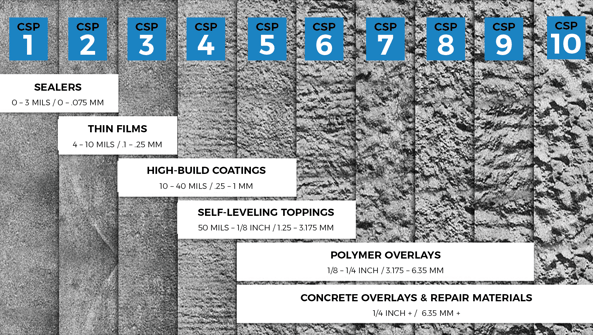
#2
Concrete hardness & the Mohs Hardness scale
Understanding the “hardness” or “abrasion strength” of your concrete and being able to communicate that hardness accurately and consistently is critical when polishing or just profiling your concrete floors. What do we use for communicating concrete hardness?
The Mohs concrete hardness test kit
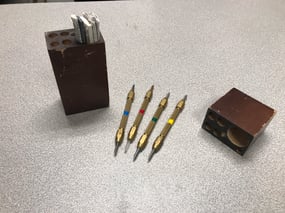
The Mohs hardness scale is a 1 – 10 chart with 1 being the softest and 10 being the hardest. It has eight "pic tips" made of materials of different hardness’s. You basically start with a higher number pic and scratch the floor, and it goes like this, a #9 leaves a scratch, a # 8 - 7 & 6 leaves a scratch but a #5 does not. so your floor hardness is in-between 5 & 6, a 5.5 (medium hardness)....no guesswork... The following is a chart with the commonly accepted range of concrete hardness in PSI (pounds per square inch)
|
MOHS Scale |
Concrete Hardness |
Common Uses |
|
#2 – 4 ½ Pic |
Soft Concrete 3,500 PSI & under |
Most homes, sidewalks |
|
#4 ½ - 7 ½ Pic |
Medium Concrete 3,500 - 5,500 PSI |
Roads, commercial buildings |
|
#7 ½ - 9 Pic |
Hard Concrete 5,000 - 6,000 PSI |
Bridges, Dams, Piers |
|
#9 + Pic |
Extra Hard 6,000 - 8,000 PSI |
Nuclear Plants |
this hardness of your concrete will determine the correct diamond “bond” you will need to be successful, and you must be able to accurately communicate that. The following will give you an idea of what diamond bond is used with either hard, medium, and soft concrete.
Very Hard Concrete (6,000-8,000 PSI) ----------- Extra Soft Bond Diamonds
Hard Concrete (5,000-6,000 PSI) ------------ Soft & Extra Soft Bond Diamonds
Medium Concrete (3,500 – 5,000 PSI) ------------ Medium Bond Diamonds
Soft Concrete (3,500 PSI and under) ------------ Hard Bond Diamonds
CLICK HERE FOR MORE INFORMATION ON HOW METAL-BOND DIAMONDS WORK
#3
Gloss level, Light reflection
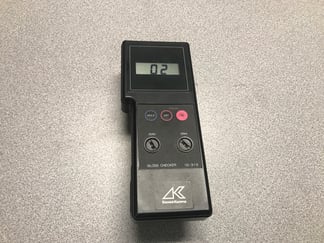
Gloss Meter
This commonly used scale simply tells us the amount of light reflecting off the floor. (This will provide ONLY a limited gauge of the clarity of the image being reflected) this 4-level chart is called the,
GLOSS LEVEL TABLE
|
Level |
Diamond Grit |
Sheen & Appearance |
Gloss Reading |
|
#1 |
100 or less |
None to very little sheen, no reflectivity. |
No reading |
|
#2 |
100 - 400 |
Low to medium sheen and matte or satin appearance with slight reflection |
40-50 |
|
#3 |
800 and higher |
Medium to high sheen with objects reflected are identifiable but not sharp |
50-60 |
|
#4 |
1,500 – 3,000 |
Highly polished, high amount of light reflection |
60-80 |
The problem with a "Gloss Meter" is that it gives you the amount of light reflection, or the "shine" but quite possibly not the "clarity" of reflected images, that's why we need the next chart, it will cover.....
#4
R.I.Q. Reflected Image Quality
#5
D.O.I. Distinction Of Image
&
#6
Level of polished concrete FINISH
For a more in-depth gauge on clarity of reflection in Concrete, there is now charts for that, they MEASURE D.O.I. (Distinctiveness Of Image) & R.I.Q. (Reflected Image Quality) these charts have a range between 1 – 100, 1 being very hazy and unclear to 100 being crisp, clear, with an almost perfect mirror like reflection. And is divided into the following 4 categories,
Note, this chart gives both the clarity reading and the 4 levels of polished concrete.
POLISHED CONCRETE APPEARANCE CHART
|
Level of polish |
Name |
Description of clarity |
D.O.I. & R.I.Q. Image Clarity Value |
Finish Grit |
|
#1 |
Basic Flat Grind |
Objects are not discernable |
0 - 9 |
100-200 Grit |
|
#2 |
Satin, Matte Finish |
Images have a matte, indistinct appearance, with a little reflection from a distance |
10 - 39 |
400 Grit |
|
#3 |
Semi-Polished Finish |
Images are now identifiable but lack a sharp, crisp appearance |
40 - 69 |
800 Grit |
|
#4 |
Highly Polished Finish |
Objects now have a mirror like reflection with crisp, sharp reflection |
70 - 100 |
1,500 – 3,000 Grit |
#7
Aggregate Exposure Table
This table classes polished concrete to four levels, A – D
|
CLASS |
NAME |
APPROXIMATE DEPTH OF THE CUT |
APPERANCE |
|
A |
Cream Polish |
None |
Polished cream, possible areas of light salt & pepper exposure |
|
B |
Fine Aggregate (salt & pepper) |
1/16 inch |
Fine aggregate exposure with possible random areas of larger aggregate |
|
C |
Medium Aggregate |
1/8 inch |
Medium aggregate exposure with some areas of larger aggregate |
|
D |
Large Aggregate |
1/4 |
Large aggregate with little amounts of finer aggregate |
Check out this example....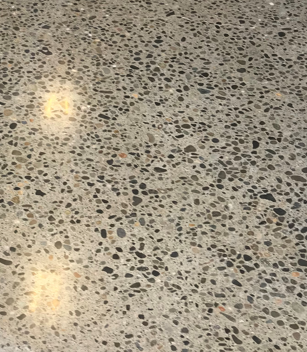
No ambiguity here, check the charts,
- This is a CLASS D Large aggregate exposure (according to the chart).
- Gloss level chart, it is a #3.
- R.I.Q. & D.O.I. charts, level of 40 - 69.
- Level of polish, a #3 finish.
- C.S.P. (Concrete surface profile) clearly a 0 (Glass-like completely smooth finish)
So, we are able to accurately describe this concrete image to everyone, as long as we all (Contractors, End-users, architects, & manufacturers)
USE THE CHARTS
CLICK HERE FOR MORE INFORMATION ON WHAT EQUIPMENT DO YOU NEED TO POLISH CONCRETE
So, the good news about charts is that when they are used we are all “speaking the same language” there is clarity in what is required, what we are working with. No more miscommunication or ambiguity on these 7 important aspects to grinding and polishing concrete.
- CSP, concrete profile, how rough the surface is.
- MOHS hardness scale, we know the hardness of our concrete.
- GLOSS LEVEL, how much light is being reflected off the floor.
- RIQ, Reflected Image Quality, how sharp an image is produced.
- D.O.I. Distention of image
- Level of polish
- Aggregate Exposure Table, how much aggregate, if any is exposed.

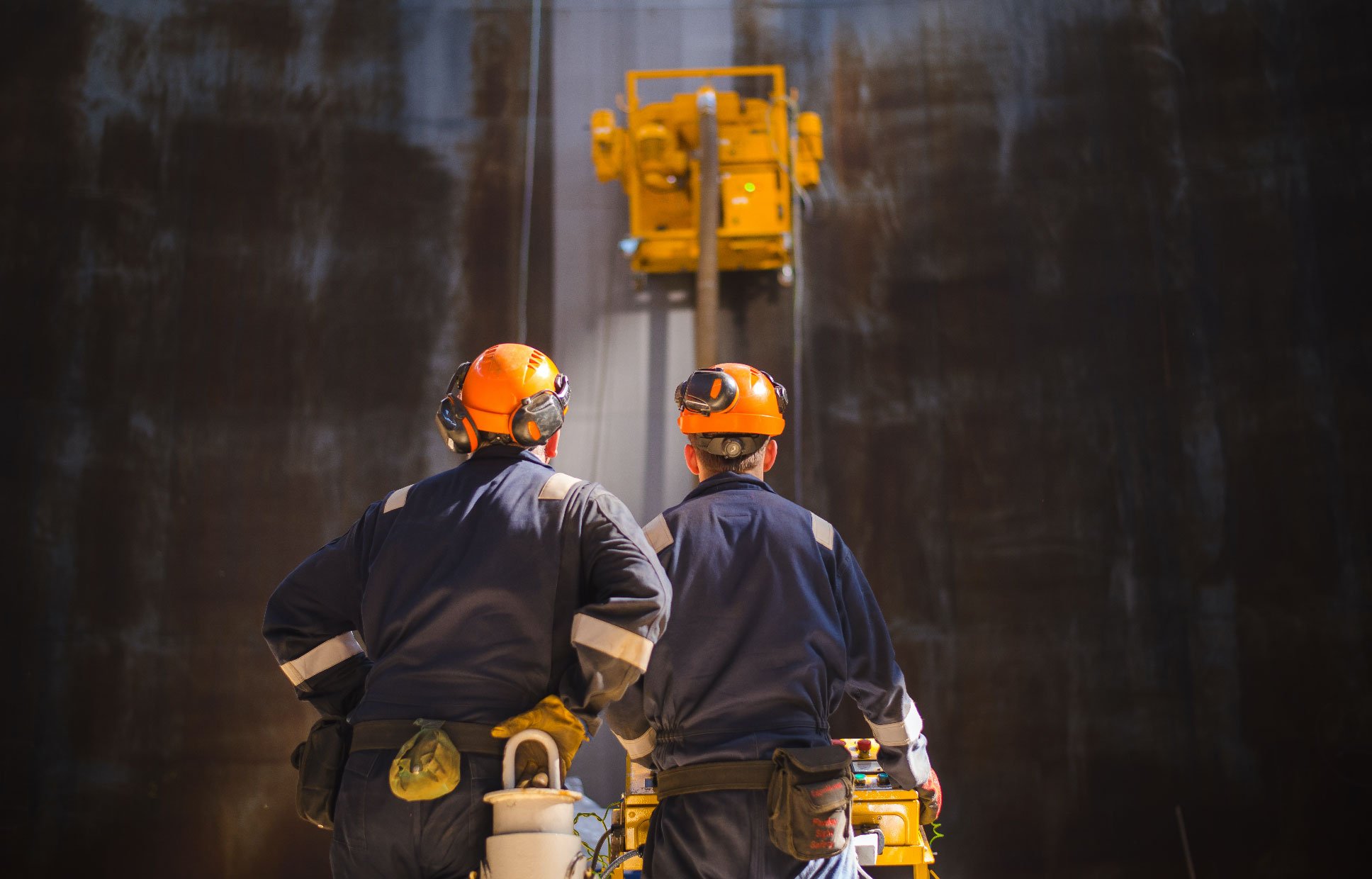
 By
By